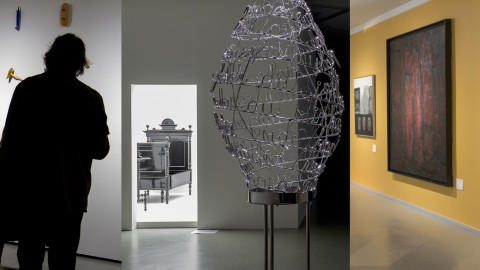Gems from the ateneum
5 June – 29 August, Holvi
Herman and Elisabeth Hallonblad – Art Patrons from Ladoga Karelia
The state councilman Herman Hallonblad (1825–1894) and his wife Elisabeth Hallonblad (1831–1907) from Sortavala were the most significant supporters of the Finnish and Karelian culture, in their time. Ladoga Karelia was formerly an area of Finland which was ceded to the Soviet Union after the Second World War.
Herman Hallonblad was the mayor of Käkisalmi in Karelia and worked as a bank manager in Helsinki. He was the owner of three estates in Karelia and one in Häme. In 1851 he married Lisinka (Elisabeth) Siitoin, whose father left her an enormous fortune. The Hallonblad family financed the lumber and metal plants. They also valued education and were establishing the Sortavala teacher seminar in Karelia.
Last year marked the 100th anniversary of the Hallonblad donation to Finnish Art Association. The donation consists of 13 pieces of art from Hallonblad’s home. Later, several paintings, drawings, sculptures and prints were bought by the Finnish Art Association with Hallonblad’s funds. The entire collection consists of 185 works of art, which are now part of the Ateneum Art Museum’s collection. In Jyväskylä exhibition there are shown 42 paintings and sculptures of the most significant Finnish artists from 1860s –1930s.
The collection includes treasures such as Helene Schjerfbeck’sT he Primary School Girl II (1908) and Self-Portrait, Black Background (1915), Ferdinand von Wright’s Capercaillies courting (1862) and The Surprise (1880), Walter Runeberg’s Sleeping Cupid (1875), Magnus Enckell’s Fantasy (1895), Maria Wiik’s In the Church (1884), Väinö Kunnas’ The Grey Dance (1928), Otto Mäkilä’s Summer Night (1938) as well as Tyko Sallinen’s The "Ducat" Girl (1914) and The Nude (1911). An interesting section of this exhibition is dedicated to portraits and the artists’ self-portraits.
Central Finland is also a common denominator for several of the pieces in this collection. Akseli Gallen-Kallela painted the first version of First Lesson, in the spirit of Runeberg in Keuruu in 1887, even though the painting was later finished in Paris in 1889. Yrjö Ollila’s Shepherdess (1915) was painted in Korpilahti. Furthermore, the exhibition includes Korpilahti born Alvar Cawén’s painting Mimosa (1914). Wilho Sjöström and Magnus Enckell, among others in this exhibition, also painted in Central Finland.
The acquisition of the exhibition was initiated by the Sortavala Foundation. This touring exhibition was brought together by the Ateneum Art Museum, the Joensuu Art Museum and the Jyväskylä Art Museum. The research related to this exhibition was done by M.Phil. Marjo-Riitta Simpanen.
The Collection was exhibited in Joensuu on 19 November 2009 – 16 May 2010. The Ateneum Art Museum will show this collection on 10 October 2010 – 14 March 2011.

